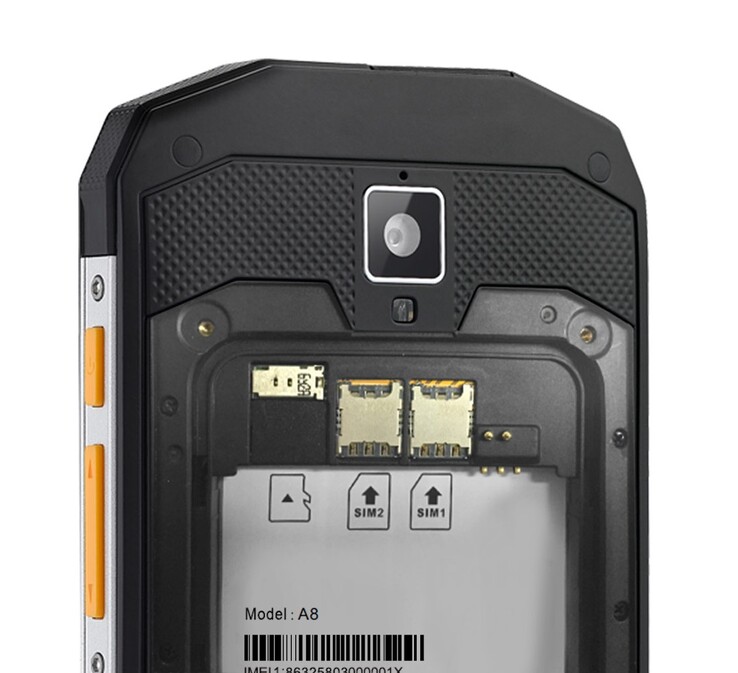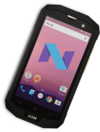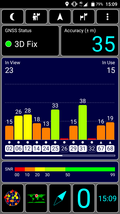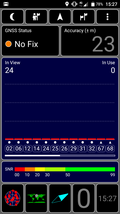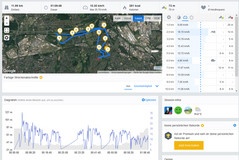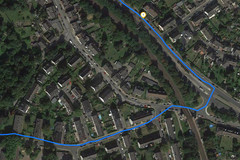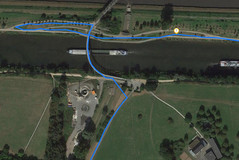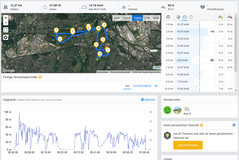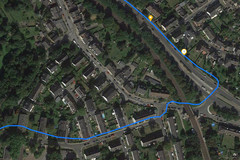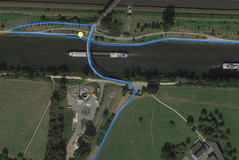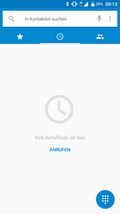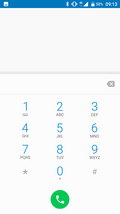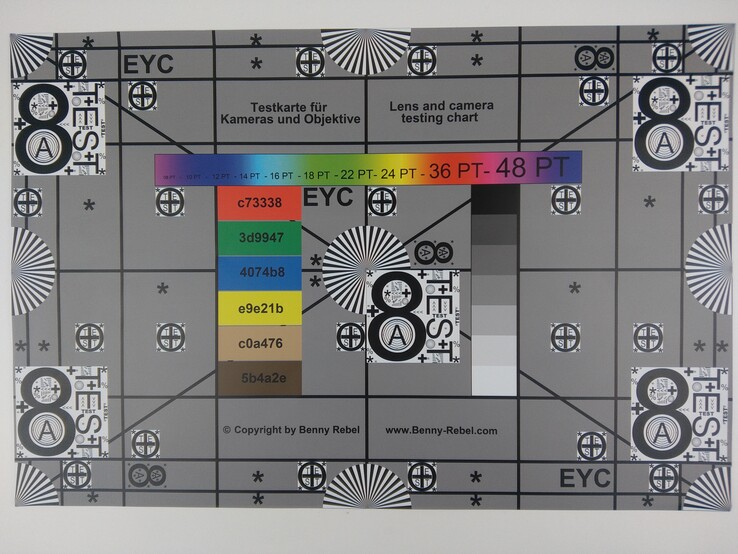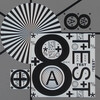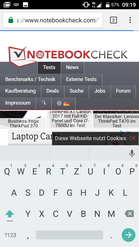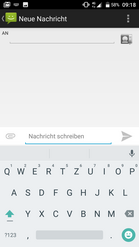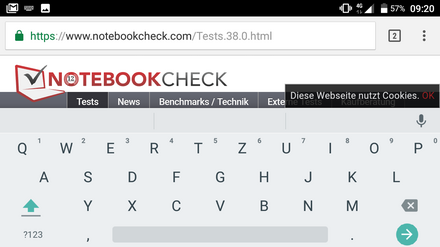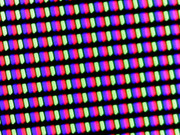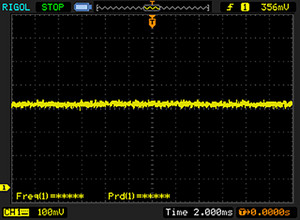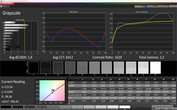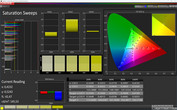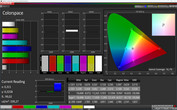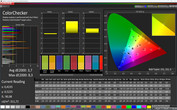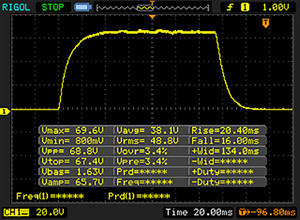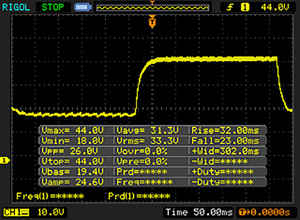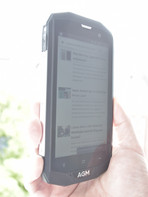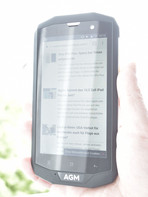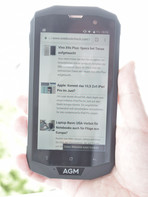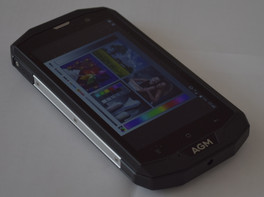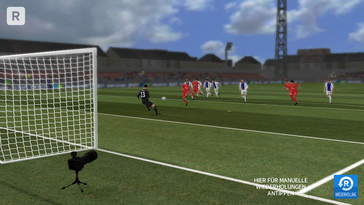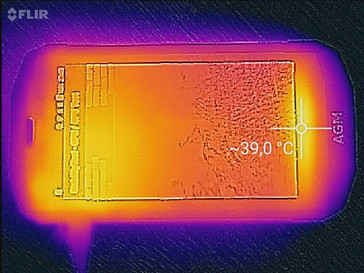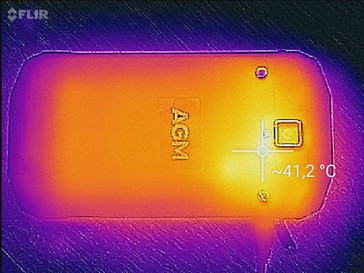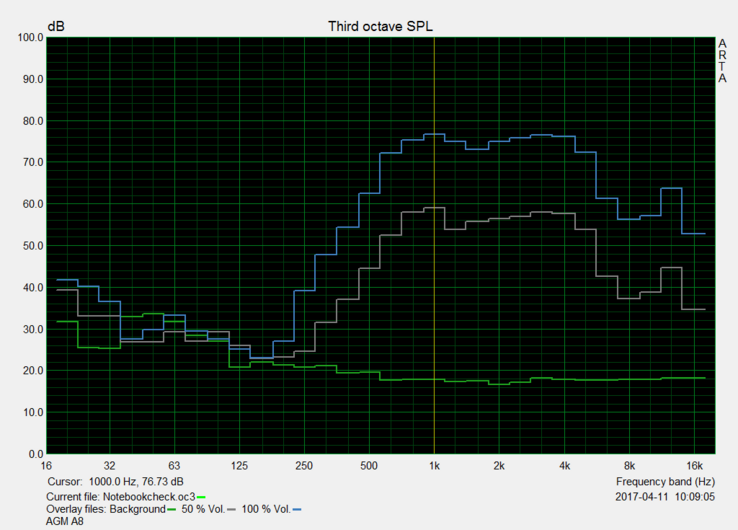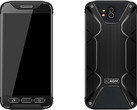AGM A8 Smartphone Review

For the original German review, see here.
The European and US markets are becoming increasingly important to Chinese smartphone manufacturers. Not only to the big guns like Huawei, who have become more popular in the recent years, but also to much smaller niche market manufacturers. A good example is the outdoor smartphone segment, which has recently been entered by Chinese phone maker AGM.
As expected for an outdoor smartphone, the AGM A8 is IP68 dust and waterproof. More specifically, this means that it can be submerged in 1 m (3 ft) deep water for up to 30 minutes, and is completely dustproof at all times. Furthermore, the phone features a very sturdy 5-inch display running at 1280x720 (HD) and a high capacity 4050 mAh battery. It runs Android 7.0 and can take two Nano SIM cards. A 13-MP main camera is pretty common in this price range, the secondary 2-MP front facing camera, however, is subpar. Unlike many other smartphones in this price range the A8 fully supports NFC.
Its competitors are a mixed bag, literally. The outdoor smartphones Nomu S30 and Archos 50 Saphir are much more expensive, at around 265 Euros ($297) and 220 Euros ($247), respectively. The Lenovo Moto G5 and LG K10 cost around the same as the AGM A8, both are running Android 7.0 and have similar specifications (13-MP main camera, LTE, 5-inch display, FHD resolution on the G5), but they are most definitely no outdoor smartphones.
Case
The AGM A8 is only available in black and – being an outdoor smartphone – very well built. While its 4050 mAh battery is user replaceable, it is quite a feat: after unscrewing the rear cover with the enclosed miniature screw driver, the battery hides behind yet another cover.
The phone can easily withstand drops from a height of 1 m (3 ft) since the sides are one with the frame, are made of very rigid and solid plastic, and absorb the shock of sudden impact very well. Applying pressure to the back has no effect on the phone whatsoever, and it holds itself without batting an eye.
The obvious downsides to a construction like this are size and weight, and the AGM A8 weighs a hefty 248 g (around 9 oz) and measures an impressive 159 x 83 x 16 mm (6.3 x 3.3 x 0.63 inches). Therefore, it might actually be too large for your pants’ pockets.
Connectivity
The AGM A8 is equipped with 32 GB of internal storage, which is not only very good for phones in this price range, but also rather uncommon with outdoor smartphones at large. It can further be upgraded with another 32 GB through microSD storage. However, the microSD card slot is hidden all the way on the inside (think outdoor), and thus it takes a while to get to it (rear cover, battery flap, battery).
Fortunately, the MicroUSB 2.0 port is accessible from the outside, but well protected and hidden behind a thick robust rubber flap that requires a significant amount of force and fingernails to give in. A status and notification LED is missing.
The AGM A8 is powered by the Qualcomm Snapdragon 410, an ARM-based mid-range SoC made for smartphones and tablets. First introduced in December 2013, it was Qualcomm’s first 64-bit SoC and is equipped with four Cortex-A53 cores with up to 1.4 GHz and the Adreno 306 GPU. It also includes a 32/64-bit LPDDR2/3 memory controller (max. 533 MHz, 8.5 GB/s) and supports Wi-Fi, Bluetooth, and 2G/3G/4G/LTE.
Given the Adreno 306’s low 450 MHz clock speed, we expected modern games from Google’s Play Store to perform rather poorly, and they did. They are far from smooth, all but unplayable, and produce massive stutter and lag.
Software
The AGM A8 boots into a standard Vanilla Android 7.0 (Nougat) operating system, and while the user interface has remained untouched by the manufacturer, a few so-called outdoor tools are preloaded on the device. These include a spirit level, tape measure, magnifying glass, altimeter, graduator, and a protractor. In addition, fitness trackers can be connected via Bluetooth, and an SOS button is also available.
Communication and GPS
The Wi-Fi module supports 802.11b/g/n only in the 2.4 GHz band. Compared to the Nomu S30 and Archos 50 Saphir, it performed much worse when connected to our reference router, a Linksys EA 8500, and only managed a meager 26.9 Mbit/s. Standing right next to the O2 HomeBox 2 Wi-Fi router loss was at a low -33 dBm.
In addition to 2G (GSM) and 3G (UMTS), the AGM A8 also supports 4G/LTE data on both its Nano SIMs. Bluetooth 4.0 is also included. Rarely ever to be found in a device in this price range, is NFC, which the AGM A8 surprised us with.
| Networking | |
| iperf3 transmit AX12 | |
| Nomu S30 | |
| Archos 50 Saphir | |
| AGM A8 | |
| iperf3 receive AX12 | |
| Nomu S30 | |
| Archos 50 Saphir | |
| AGM A8 | |
GPS based location services are more precise than what we have come to expect from affordable smartphones. It worked very well indoors as well, and had no trouble obtaining a GPS lock on our position pretty much immediately.
During our 12 km (7.5 miles) long test trip, it had to prove itself against the bicycle GPS Garmin Edge 500. The A8 tends to cut corners and often relocated us from the bike path onto the main road, thereby reducing the total distance travelled after finishing our trip by 280 m (919 ft).
Telephone and Call Quality
The A8 uses Google’s default Android dialer app that includes favorites and a call log. Unfortunately, the virtual keys are not visually separated from one another, but they are quite large and thereby easy to operate.
The indoor call quality leaves a lot to be desired. On the receiving end, we have had trouble following the conversation due to a lack of volume and pretty muffled voices. Outside call quality was better. Unfortunately, the speakers are rattling noticeably, thereby making it hard to understand our conversational partners on speakerphone.
Cameras
AGM provides almost no specifications on the A8’s cameras. The rear facing main camera features a 13-MP sensor with auto focus and a single LED flash. It records videos in FHD at 30 frames per second. A physical shutter button is missing.
As is rather common for devices in this price range, photography is not one of the AGM A8’s big selling points. In low-light conditions photos are dull and dark. Compared to our reference camera, an EOS 70 D, colors are flat in overcast conditions, and objects in direct sunlight are noticeably more colorful and lively. Despite its 13-MP sensor, images are never really crisp and they tend to blur at the edges. The autofocus works well and shutter lag is decent.
The smartphone’s secondary front facing camera only features a 2-MP sensor and fix focus. It is okay for quick, random snaps but definitely not for ambitious group selfies due to the lack of a wide angle lens. Furthermore, as is very common for devices in this price range, there is no front facing flash.
Accessories and Warranty
The package contains the usual: an English quick start guide, a cable that can be used for charging as well as data transfer, and a charger. A headset was not included. However, we found a small screw driver in the box that can be used for taking off the rear cover to access the battery. AGM offers a 12-month limited warranty. Please see our Guarantees, Return policies and Warranties FAQ for country-specific information.
Input Devices & Handling
The usual set of three capacitive buttons – back, home, and multitasking view – are available right below the display. Unfortunately, they only light up on contact. For text input the A8 uses Google’s standard Android keyboard.
Due to the fact that the A8 prides itself as “outdoor smartphone”, the touchscreen is less sensitive than expected. While it requires a little bit of extra force to trigger an action, it did not lack precision.
Display
| |||||||||||||||||||||||||
Brightness Distribution: 93 %
Center on Battery: 356 cd/m²
Contrast: 1695:1 (Black: 0.21 cd/m²)
ΔE ColorChecker Calman: 3.7 | ∀{0.5-29.43 Ø4.78}
ΔE Greyscale Calman: 1.9 | ∀{0.09-98 Ø5}
Gamma: 2.5
CCT: 6412 K
| AGM A8 IPS, 1280x720, 5" | Archos 50 Saphir IPS, 1280x720, 5" | Nomu S30 IPS, 1920x1080, 5.5" | Samsung Galaxy S8 Super AMOLED, 2960x1440, 5.8" | LG G6 IPS LCD, 2880x1440, 5.7" | |
|---|---|---|---|---|---|
| Screen | -158% | -74% | 21% | -3% | |
| Brightness middle (cd/m²) | 356 | 545 53% | 423 19% | 566 59% | 646 81% |
| Brightness (cd/m²) | 343 | 527 54% | 421 23% | 564 64% | 611 78% |
| Brightness Distribution (%) | 93 | 87 -6% | 93 0% | 94 1% | 89 -4% |
| Black Level * (cd/m²) | 0.21 | 0.58 -176% | 0.26 -24% | 0.23 -10% | |
| Contrast (:1) | 1695 | 940 -45% | 1627 -4% | 2809 66% | |
| Colorchecker dE 2000 * | 3.7 | 12.5 -238% | 7.8 -111% | 2.7 27% | 4.5 -22% |
| Colorchecker dE 2000 max. * | 8.3 | 24.4 -194% | 14.5 -75% | 5.4 35% | 8.3 -0% |
| Greyscale dE 2000 * | 1.9 | 15.4 -711% | 9.8 -416% | 3.1 -63% | 6 -216% |
| Gamma | 2.5 88% | 1.87 118% | 2.32 95% | 2.15 102% | 2.27 97% |
| CCT | 6412 101% | 12705 51% | 9828 66% | 6335 103% | 7996 81% |
| Color Space (Percent of AdobeRGB 1998) (%) | 81.57 | 67.74 | |||
| Color Space (Percent of sRGB) (%) | 99.87 | 99.05 |
* ... smaller is better
Screen Flickering / PWM (Pulse-Width Modulation)
| Screen flickering / PWM not detected | |||
In comparison: 53 % of all tested devices do not use PWM to dim the display. If PWM was detected, an average of 8108 (minimum: 5 - maximum: 343500) Hz was measured. | |||
The maximum brightness of 330 nits is nothing to write home about, but at least brightness distribution was very even at 93%. With the ambient light sensor enabled, the display reached a maximum of 356 nits. The real life APL50 test (Average Picture Level) with equally spaced bright and dark areas measured a similar brightness of 340 nits in the middle of the screen, and a black level of 0.32 nits.
The IPS panel’s colors seem comparatively dull overall, and contrast ratio, sRGB color coverage, color temperature, and DeltaE deviation for colors and gray scales were acceptable for a device in this price range.
Display Response Times
| ↔ Response Time Black to White | ||
|---|---|---|
| 36.4 ms ... rise ↗ and fall ↘ combined | ↗ 20.4 ms rise | |
| ↘ 16 ms fall | ||
| The screen shows slow response rates in our tests and will be unsatisfactory for gamers. In comparison, all tested devices range from 0.1 (minimum) to 240 (maximum) ms. » 95 % of all devices are better. This means that the measured response time is worse than the average of all tested devices (20.2 ms). | ||
| ↔ Response Time 50% Grey to 80% Grey | ||
| 55 ms ... rise ↗ and fall ↘ combined | ↗ 32 ms rise | |
| ↘ 23 ms fall | ||
| The screen shows slow response rates in our tests and will be unsatisfactory for gamers. In comparison, all tested devices range from 0.165 (minimum) to 636 (maximum) ms. » 91 % of all devices are better. This means that the measured response time is worse than the average of all tested devices (31.6 ms). | ||
Performance
The AGM A8’s Qualcomm Snapdragon 410 SoC has already proven itself numerous times, and is fast enough for everyday use. It lacks the oomph for smooth gaming, though. Furthermore, subjectively the A8 was comparatively slow in loading and rendering websites with the included Chrome browser, which is only partially reflected in our benchmarks. Most of the time, the AGM A8 came in either last or second to last.
The available storage space is excellent for its price range. After all, it offers 32 GB of storage. MicroSD storage is slower than on top tier smartphones, but still decently fast considering the price of the device. It scored 95 MB/s and 80 MB/s reading from and writing to our Toshiba Exceria Pro M401 reference card, respectively, and Androbench 5 results reading small and large chunks of data were very good overall.
| AnTuTu v6 - Total Score (sort by value) | |
| AGM A8 | |
| Archos 50 Saphir | |
| Nomu S30 | |
| LG G6 | |
| Asus Zenfone Go ZB500KL | |
| GFXBench (DX / GLBenchmark) 2.7 | |
| T-Rex Onscreen (sort by value) | |
| AGM A8 | |
| Archos 50 Saphir | |
| Nomu S30 | |
| Samsung Galaxy Xcover 3 | |
| LG G6 | |
| Asus Zenfone Go ZB500KL | |
| 1920x1080 T-Rex Offscreen (sort by value) | |
| AGM A8 | |
| Archos 50 Saphir | |
| Nomu S30 | |
| Samsung Galaxy Xcover 3 | |
| LG G6 | |
| Asus Zenfone Go ZB500KL | |
| GFXBench 3.0 | |
| on screen Manhattan Onscreen OGL (sort by value) | |
| AGM A8 | |
| Archos 50 Saphir | |
| Nomu S30 | |
| Samsung Galaxy Xcover 3 | |
| LG G6 | |
| Asus Zenfone Go ZB500KL | |
| 1920x1080 1080p Manhattan Offscreen (sort by value) | |
| AGM A8 | |
| Archos 50 Saphir | |
| Nomu S30 | |
| Samsung Galaxy Xcover 3 | |
| LG G6 | |
| Asus Zenfone Go ZB500KL | |
| GFXBench 3.1 | |
| on screen Manhattan ES 3.1 Onscreen (sort by value) | |
| Archos 50 Saphir | |
| Nomu S30 | |
| LG G6 | |
| Asus Zenfone Go ZB500KL | |
| 1920x1080 Manhattan ES 3.1 Offscreen (sort by value) | |
| Archos 50 Saphir | |
| Nomu S30 | |
| LG G6 | |
| Asus Zenfone Go ZB500KL | |
| PCMark for Android - Work performance score (sort by value) | |
| AGM A8 | |
| Nomu S30 | |
| LG G6 | |
| Asus Zenfone Go ZB500KL | |
| Geekbench 4.4 | |
| 64 Bit Multi-Core Score (sort by value) | |
| AGM A8 | |
| LG G6 | |
| 64 Bit Single-Core Score (sort by value) | |
| AGM A8 | |
| LG G6 | |
| AndroBench 3-5 | |
| Sequential Read 256KB (sort by value) | |
| AGM A8 | |
| Archos 50 Saphir | |
| Nomu S30 | |
| Samsung Galaxy Xcover 3 | |
| LG G6 | |
| Asus Zenfone Go ZB500KL | |
| Sequential Write 256KB (sort by value) | |
| AGM A8 | |
| Archos 50 Saphir | |
| Nomu S30 | |
| Samsung Galaxy Xcover 3 | |
| LG G6 | |
| Asus Zenfone Go ZB500KL | |
| Random Read 4KB (sort by value) | |
| AGM A8 | |
| Archos 50 Saphir | |
| Nomu S30 | |
| Samsung Galaxy Xcover 3 | |
| LG G6 | |
| Asus Zenfone Go ZB500KL | |
| Random Write 4KB (sort by value) | |
| AGM A8 | |
| Archos 50 Saphir | |
| Nomu S30 | |
| Samsung Galaxy Xcover 3 | |
| LG G6 | |
| Asus Zenfone Go ZB500KL | |
| Sequential Read 256KB SDCard (sort by value) | |
| AGM A8 | |
| Archos 50 Saphir | |
| Nomu S30 | |
| LG G6 | |
| Asus Zenfone Go ZB500KL | |
| Sequential Write 256KB SDCard (sort by value) | |
| AGM A8 | |
| Archos 50 Saphir | |
| Nomu S30 | |
| LG G6 | |
| Asus Zenfone Go ZB500KL | |
Gaming
Emissions
Temperature
The outdoor smartphone remained cool during everyday use. During our stress test, running an application stability test for at least one full hour, the hot spot at the front heated up to a maximum of 36.5 °C (~98 °F) while most of the rear side remained below 34 °C (~93 °F).
(+) The maximum temperature on the upper side is 36.6 °C / 98 F, compared to the average of 35.2 °C / 95 F, ranging from 21.9 to 247 °C for the class Smartphone.
(+) The bottom heats up to a maximum of 36.5 °C / 98 F, compared to the average of 34 °C / 93 F
(+) In idle usage, the average temperature for the upper side is 30.5 °C / 87 F, compared to the device average of 32.9 °C / 91 F.
Speakers
The AGM A8’s powerful mono speaker is located on the rear side and reached a maximum noise level of 85.78 dB(A), which is pretty normal for devices in this price range. Unfortunately, sound quality was quite bad and the speaker suffered from very noticeable and distracting rattling.
The sound pattern between 500 Hz and 7 kHz is rather erratic. Low frequencies (bass) are imperceptible, and highs above 8 kHz are underrepresented as well.
Unfortunately, AGM does not include a headset in the box. In combination with the Sony SBH60 headset the headphone jack performed rather poorly, which is not uncommon for devices in this price range. However, white noise was acceptable.
AGM A8 audio analysis
(+) | speakers can play relatively loud (85.8 dB)
Bass 100 - 315 Hz
(-) | nearly no bass - on average 30.9% lower than median
(±) | linearity of bass is average (11.7% delta to prev. frequency)
Mids 400 - 2000 Hz
(±) | higher mids - on average 10% higher than median
(±) | linearity of mids is average (9.7% delta to prev. frequency)
Highs 2 - 16 kHz
(±) | higher highs - on average 9.1% higher than median
(±) | linearity of highs is average (7.3% delta to prev. frequency)
Overall 100 - 16.000 Hz
(-) | overall sound is not linear (32.8% difference to median)
Compared to same class
» 83% of all tested devices in this class were better, 1% similar, 15% worse
» The best had a delta of 11%, average was 35%, worst was 134%
Compared to all devices tested
» 92% of all tested devices were better, 1% similar, 7% worse
» The best had a delta of 4%, average was 24%, worst was 134%
Samsung Galaxy S8 audio analysis
(+) | speakers can play relatively loud (82.4 dB)
Bass 100 - 315 Hz
(-) | nearly no bass - on average 22.1% lower than median
(±) | linearity of bass is average (11.7% delta to prev. frequency)
Mids 400 - 2000 Hz
(±) | higher mids - on average 5% higher than median
(+) | mids are linear (4.3% delta to prev. frequency)
Highs 2 - 16 kHz
(+) | balanced highs - only 3.7% away from median
(+) | highs are linear (6.7% delta to prev. frequency)
Overall 100 - 16.000 Hz
(±) | linearity of overall sound is average (21.8% difference to median)
Compared to same class
» 44% of all tested devices in this class were better, 8% similar, 48% worse
» The best had a delta of 11%, average was 35%, worst was 134%
Compared to all devices tested
» 61% of all tested devices were better, 7% similar, 32% worse
» The best had a delta of 4%, average was 24%, worst was 134%
Frequency comprison (checkboxes selectable/deselectable!)
Energy Management
Power Consumption
Overall power consumption was higher than average, yet lower than average under high load.
| Off / Standby | |
| Idle | |
| Load |
|
Key:
min: | |
| AGM A8 4050 mAh | Archos 50 Saphir 5000 mAh | Nomu S30 5000 mAh | LG G6 3300 mAh | Samsung Galaxy Xcover 3 mAh | |
|---|---|---|---|---|---|
| Power Consumption | 0% | -6% | 1% | 39% | |
| Idle Minimum * (Watt) | 0.86 | 0.65 24% | 0.93 -8% | 0.62 28% | 0.6 30% |
| Idle Average * (Watt) | 1.97 | 1.9 4% | 2.31 -17% | 1.43 27% | 1.2 39% |
| Idle Maximum * (Watt) | 2.04 | 2.05 -0% | 2.35 -15% | 1.48 27% | 1.3 36% |
| Load Average * (Watt) | 4.86 | 6.14 -26% | 4.57 6% | 5.52 -14% | 2.6 47% |
| Load Maximum * (Watt) | 6.43 | 6.54 -2% | 6.1 5% | 10.47 -63% | 3.6 44% |
* ... smaller is better
Battery Life
Despite its large 4050 mAh battery, the device lasted for a mediocre of just 654 minutes in our Wi-Fi test at normalized brightness (150 nits). Charging a completely drained battery takes around two hours with the included 5 W (5 V / 1 A) charger, and the charging process is very linear: the battery is charged to 50% after one hour.
| AGM A8 4050 mAh | Nomu S30 5000 mAh | Archos 50 Saphir 5000 mAh | LG G6 3300 mAh | Samsung Galaxy Xcover 3 mAh | |
|---|---|---|---|---|---|
| Battery runtime | |||||
| WiFi v1.3 (h) | 10.9 | 13.9 28% | 16.2 49% | 11.5 6% | 8.4 -23% |
Pros
Cons
Verdict
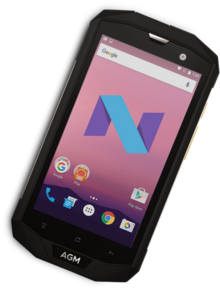
The AGM A8's biggest selling point is its price: the smartphone can be purchased for around 180 Euros ($150) online. Despite its low price, it runs Google’s latest Android 7.0 operating system, and features 4G/LTE for both SIM cards, a decently bright and scratch-resistant 5-inch HD display, and a large battery. Unlike other smartphones that pride themselves with their supposedly water and dust resistance, the AGM A8 is a very potent and rugged companion when hiking out in the wild or working on a construction site.
This ruggedness comes at a price, though. In order to get to the MicroSD or the two Nano SIM cards, the rear cover has to be removed, which is a rather arduous procedure. Its relatively low overall performance, poor cameras, and less than stellar sound quality can all be attributed to the device’s low price.
AGM A8
- 05/18/2017 v6 (old)
Thomas Meyer




